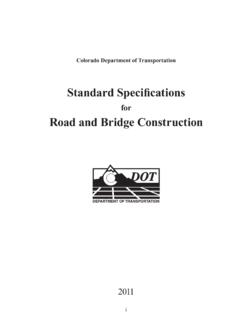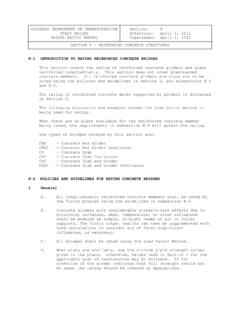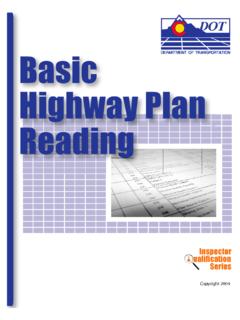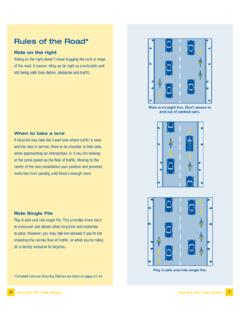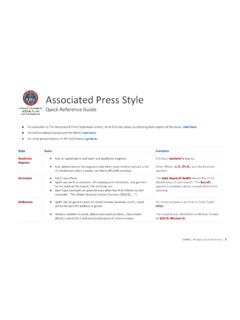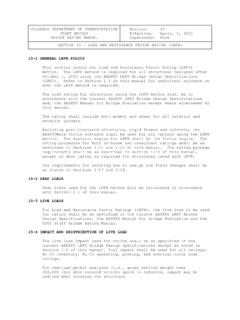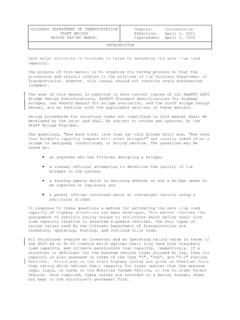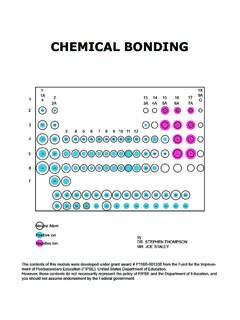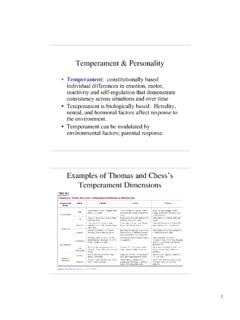Transcription of CHAPTER 9 INTERSECTIONS - Colorado Department of ...
1 2005 INTERSECTIONS CHAPTER 9 INTERSECTIONS INTRODUCTION INTERSECTIONS are intended to operate with vehicles, pedestrians, and bicycles proceeding in many directions, often at the same time. At such locations, traffic movements on two or more facilities are required to occupy a common area. It is this unique characteristic of INTERSECTIONS , the repeated occurrence of conflicts, that is the basis for most intersection design standards, criteria, and proper operating procedures.
2 An intersection is defined as the general area where two or more highways join or cross, including the roadway and roadside facilities for traffic movements within it. Each highway radiating from an intersection and forming part of it is an intersection leg. The common intersection of two highways crossing each other has four legs. It is not recommended that an intersection have more than four legs. An intersection is an important part of a highway system because, to a great extent, the efficiency, safety, speed, cost of operation, and capacity depend on its design.
3 Each intersection involves through or cross-traffic movements on one or more of the highways concerned and may involve turning movements between these highways. These movements may be handled by various means, such as signals, signing, and channelization, depending on the type of intersection . GENERAL DESIGN CONSIDERATIONS AND OBJECTIVES The main objective of intersection design is to reduce the potential conflicts between motor vehicles, bicycles, pedestrians, and facilities while facilitating the convenience, ease, and comfort of the people traversing the intersection .
4 The design should be fitted closely to the natural transitional paths and operating characteristics of the users. Five basic elements enter into design considerations of INTERSECTIONS : Human factors Traffic considerations Physical elements Economic factors Functional intersection areas Although INTERSECTIONS have many common factors, they are not subject to class treatment, and they must be treated as individual problems. TYPES AND EXAMPLES OF INTERSECTIONS 9-1 INTERSECTIONS 2005 General Considerations The basic types of at-grade INTERSECTIONS are the T- intersection (with multiple variations of angular approach), the four-leg intersection , the multi-leg INTERSECTIONS and roundabouts (see CHAPTER 19 and the FHWA Roundabout Guide).
5 In each particular case, the type is determined primarily by the number of intersecting legs, the topography, the traffic pattern, and the desired type of operation. A basic intersection type can vary greatly in scope, shape, and degree of channelization. Once the type of intersection is established, the design controls and criteria covered in CHAPTER 2 and the elements of intersection design given in CHAPTER 3 as well as in this CHAPTER must be applied to arrive at a suitable geometric plan. Each type of intersection is discussed separately in CHAPTER 9 of the PGDHS (1), and likely variations of each are demonstrated.
6 It is not practical to discuss all possible variations, but the types demonstrated are sufficient to cover the general application of at-grade intersection design. Many other variations of types and treatment may be found in the NCHRP Report 279 (2), which shows examples in detail that are not included in this Guide. CAPACITY ANALYSIS Capacity and level of service analysis is one of the most important considerations in the design of INTERSECTIONS . This subject is discussed at length in CHAPTER 2 of the PGDHS (1) and is discussed throughout this CHAPTER as it relates to the various elements of intersection design.
7 Optimum capacities can be obtained when at-grade INTERSECTIONS include auxiliary lanes, proper use of channelization, and traffic control devices. For more complete coverage of capacity of INTERSECTIONS , including procedures for making capacity computations, refer to CHAPTER 6 of the Highway Capacity Manual (3). ALIGNMENT AND PROFILE General Considerations Horizontal and vertical alignment and cross-sectional features affect driver and/or vehicle behavior at and on the approach to the intersection , and therefore are important design considerations.
8 The horizontal and vertical alignment of the intersecting roads should permit users to readily discern and perform the maneuvers necessary to pass through the INTERSECTIONS safely and with a minimum of interference by other users. As a rule, alignment and grade are subject to greater restriction at or near intersecting roads than on the open road. Their combination at or near the intersection must produce traffic lanes that are clearly visible to the operators at all times and plainly understandable for any desired direction of travel, free from unexpected hazards, and consistent with the portions of the highway just traveled.
9 9-2 2005 INTERSECTIONS Alignment Both individual vehicle operations and the nature of vehicle conflicts are affected by the angle of intersection . Roads intersecting at acute angles require extensive turning roadway areas and tend to restrict visibility, particularly for drivers of trucks. When a truck turns on an obtuse angle, the driver has blind areas on the right of the vehicle.
10 Acute-angle INTERSECTIONS increase the exposure time of the vehicles crossing the main traffic flow and may increase the accident potential. Angles of 75 to 90 degrees are generally considered desirable. Although not desirable, a 60-degree angle is considered acceptable. New INTERSECTIONS should not include skewed angles less than 60 degrees without special design and control features to mitigate the effects of the skew. See Exhibit 9-69 in the PGDHS (1). These may include more positive traffic control (all stop, traffic signals) and/or geometric improvements such as greater corner sight distance.
